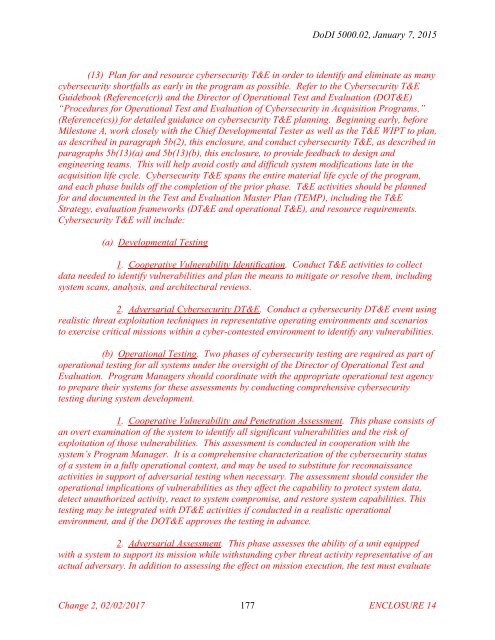Department of Defense INSTRUCTION
x9tnk
x9tnk
Create successful ePaper yourself
Turn your PDF publications into a flip-book with our unique Google optimized e-Paper software.
DoDI 5000.02, January 7, 2015<br />
(13) Plan for and resource cybersecurity T&E in order to identify and eliminate as many<br />
cybersecurity shortfalls as early in the program as possible. Refer to the Cybersecurity T&E<br />
Guidebook (Reference(cr)) and the Director <strong>of</strong> Operational Test and Evaluation (DOT&E)<br />
“Procedures for Operational Test and Evaluation <strong>of</strong> Cybersecurity in Acquisition Programs,”<br />
(Reference(cs)) for detailed guidance on cybersecurity T&E planning. Beginning early, before<br />
Milestone A, work closely with the Chief Developmental Tester as well as the T&E WIPT to plan,<br />
as described in paragraph 5b(2), this enclosure, and conduct cybersecurity T&E, as described in<br />
paragraphs 5b(13)(a) and 5b(13)(b), this enclosure, to provide feedback to design and<br />
engineering teams. This will help avoid costly and difficult system modifications late in the<br />
acquisition life cycle. Cybersecurity T&E spans the entire material life cycle <strong>of</strong> the program,<br />
and each phase builds <strong>of</strong>f the completion <strong>of</strong> the prior phase. T&E activities should be planned<br />
for and documented in the Test and Evaluation Master Plan (TEMP), including the T&E<br />
Strategy, evaluation frameworks (DT&E and operational T&E), and resource requirements.<br />
Cybersecurity T&E will include:<br />
(a) Developmental Testing<br />
1. Cooperative Vulnerability Identification. Conduct T&E activities to collect<br />
data needed to identify vulnerabilities and plan the means to mitigate or resolve them, including<br />
system scans, analysis, and architectural reviews.<br />
2. Adversarial Cybersecurity DT&E. Conduct a cybersecurity DT&E event using<br />
realistic threat exploitation techniques in representative operating environments and scenarios<br />
to exercise critical missions within a cyber-contested environment to identify any vulnerabilities.<br />
(b) Operational Testing. Two phases <strong>of</strong> cybersecurity testing are required as part <strong>of</strong><br />
operational testing for all systems under the oversight <strong>of</strong> the Director <strong>of</strong> Operational Test and<br />
Evaluation. Program Managers should coordinate with the appropriate operational test agency<br />
to prepare their systems for these assessments by conducting comprehensive cybersecurity<br />
testing during system development.<br />
1. Cooperative Vulnerability and Penetration Assessment. This phase consists <strong>of</strong><br />
an overt examination <strong>of</strong> the system to identify all significant vulnerabilities and the risk <strong>of</strong><br />
exploitation <strong>of</strong> those vulnerabilities. This assessment is conducted in cooperation with the<br />
system’s Program Manager. It is a comprehensive characterization <strong>of</strong> the cybersecurity status<br />
<strong>of</strong> a system in a fully operational context, and may be used to substitute for reconnaissance<br />
activities in support <strong>of</strong> adversarial testing when necessary. The assessment should consider the<br />
operational implications <strong>of</strong> vulnerabilities as they affect the capability to protect system data,<br />
detect unauthorized activity, react to system compromise, and restore system capabilities. This<br />
testing may be integrated with DT&E activities if conducted in a realistic operational<br />
environment, and if the DOT&E approves the testing in advance.<br />
2. Adversarial Assessment. This phase assesses the ability <strong>of</strong> a unit equipped<br />
with a system to support its mission while withstanding cyber threat activity representative <strong>of</strong> an<br />
actual adversary. In addition to assessing the effect on mission execution, the test must evaluate<br />
Change 2, 02/02/2017 177<br />
ENCLOSURE 14


